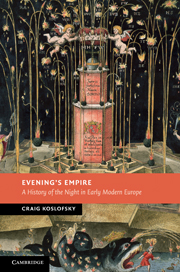Book contents
- Frontmatter
- Contents
- Figures
- Maps
- Acknowledgments
- Chapter One An early modern revolution
- Chapter Two Darkness and the Devil, 1450–1650
- Chapter Three Seeking the Lord in the night, 1530–1650
- Chapter Four Princes of darkness: the night at court, 1600–1750
- Chapter Five “An entirely new contrivance”: the rise of street lighting, 1660–1700
- Chapter Six Colonizing the urban night: resistance, gender, and the public sphere
- Chapter Seven Colonizing the rural night?
- Chapter Eight Darkness and Enlightenment
- Chapter Nine Conclusion
- Notes
- Bibliography
- Index
Chapter Four - Princes of darkness: the night at court, 1600–1750
Published online by Cambridge University Press: 05 August 2013
- Frontmatter
- Contents
- Figures
- Maps
- Acknowledgments
- Chapter One An early modern revolution
- Chapter Two Darkness and the Devil, 1450–1650
- Chapter Three Seeking the Lord in the night, 1530–1650
- Chapter Four Princes of darkness: the night at court, 1600–1750
- Chapter Five “An entirely new contrivance”: the rise of street lighting, 1660–1700
- Chapter Six Colonizing the urban night: resistance, gender, and the public sphere
- Chapter Seven Colonizing the rural night?
- Chapter Eight Darkness and Enlightenment
- Chapter Nine Conclusion
- Notes
- Bibliography
- Index
Summary
In 1687, John Norris of Bemerton (1657–1711), a lesser “metaphysical” poet, Anglican clergyman, and Tory pamphleteer, published an extraordinary “Hymn to Darkness.” Written as England’s last Catholic monarch revived hopes and fears of Stuart absolutism, Norris’s poem stands out from other English “poetry of night” through its praise of darkness as an awe-inspiring ruler:
Thy native lot thou didst to light resign,
But still half of the Globe is thine.
Here with a quiet but yet aweful hand
Like the best Emperours thou dost command.
Norris wrote within an established genre, the poetic nocturne, describing darkness, to whom “the Stars above their brightness owe,” as a “most sacred Venerable thing” complementary to and inseparable from light. But as a supporter of James II, Norris brought a new political message to the nocturne: he envisioned darkness as an essential aspect of divine and earthly majesty and authority:
Tho Light and Glory be th’Almighty’s Throne,
Darkness is his Pavilion.
From that his radiant Beauty, but from thee
He has his Terrour and his Majesty.
- Type
- Chapter
- Information
- Evening's EmpireA History of the Night in Early Modern Europe, pp. 91 - 127Publisher: Cambridge University PressPrint publication year: 2011



